

THE MAN WITH A THOUSAND FACES
by Vincent MOLLET


THE MAN WITH A THOUSAND FACES
by Vincent MOLLET
This article is meant to expand and complete (even though it sometimes conflict with) Jean-Marc Lofficier's Who Was Nobody?, throwing much
needed light on the character known variously as Cagliostro, the Count of Monte-Cristo
and Captain Nemo, and how he became immortal.
The first clues can be found in a historical event that occurred in the 17th century, and which is known to some
of the biographers of the man we knows as -- Cagliostro.
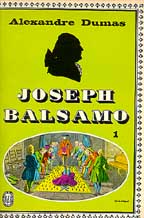 Joseph Balsamo
Joseph Balsamo
In the year 1638, a strange man settled down in the city of Toulouse, in south-western France. The only thing his
new fellow citizens knew about him was that he had been born in the Sicilian gentry, was well versed in medicine,
was a knight of the Order of the Holy Cross, looked like he was in his late thirties -- and that his name was Joseph Balsamo.
As those who have read The Conspiracy and Who Was Nobody? by Jean-Marc Lofficier
may know, this was the name of the famous 18th-century occultist, alchemist and probably secret agent, more commonly
known as Cagliostro. In reality, the 17th-century
Joseph Balsamo was probably, biologically speaking, an ancestor of Cagliostro, but one of my purposes in this article
is to show that he was, in fact, far more than that.
We don't really know what drove Joseph Balsamo to settle down in the south-west of France. Maybe this was connected
to some of the strange activities -- secret gold mining? alchemy? political conspiracy? maybe all of the above?--
that were taking place at the same time in the nearby Pyrenées mountains, more exactly in the area of Rennes-le-Château,
under the watch of a religious brotherhood, the Compagnie du Saint-Sacrement.
However, the Sicilian knight was, even more so than his homonym and descendent, a scholar and a healer. Soon, miraculous
cures were rumoured to have takewn place, secured by what Joseph Balsamo claimed to be a wonderful elixir, that
he gave for nothing to the poor who took his counsel. If Balsamo became a benefactor of the people of Toulouse,
no patient however got more attention from him than a young crippled nobleman called Joffrey
de Peyrac, later known for his association with his lover, the notorious Angélique de Sancé de Monteloup, the so-called
"Marquise of the Angels" whose life was ably chronicles by Serge
& Anne Golon.
 By the time
Joseph Balsamo came in Toulouse, Peyrac (born in 1622) was sixteen. His two legs were paralysed, and his face badly
scarred, since a childhood accident. He was nevertheless intelligent, quick-witted, curious about all arts and
sciences, especially the occult, and found great pleasure in the acquaintance of the Sicilian Knight, even before
knowing if he could cure him or not. Eventually, after many, long conversations about physics, medicine, alchemy
and spiritualism, all sciences in which Balsamo was deeply learned, the scholar proposed to his new friend the
oddest of cures. He could give him a new, perfectly healthy, although oldest body: he could give him his own body
-- in exchange for his.
By the time
Joseph Balsamo came in Toulouse, Peyrac (born in 1622) was sixteen. His two legs were paralysed, and his face badly
scarred, since a childhood accident. He was nevertheless intelligent, quick-witted, curious about all arts and
sciences, especially the occult, and found great pleasure in the acquaintance of the Sicilian Knight, even before
knowing if he could cure him or not. Eventually, after many, long conversations about physics, medicine, alchemy
and spiritualism, all sciences in which Balsamo was deeply learned, the scholar proposed to his new friend the
oddest of cures. He could give him a new, perfectly healthy, although oldest body: he could give him his own body
-- in exchange for his.
His readings had made young Peyrac familiar with the ancient Indian doctrine, also promulgated by some Greek philosophers,
of the Transmigration of Souls. He knew that, according to some tales, such a transmigration could occur, not only
between a dying person and a child ready to be born, but also between living and more or less consenting adults.
Thus, Balsamo's proposition surprised him less than it might have other people. Peyrac wasn't also much more surprised
to learn that his new friend was several centuries old, and had already had a thousand faces.
A long, long time before, the one who would be later known as Joseph Balsamo had acquired the power of separating
his astral body - or what, in 17th century terminology, was called his soul - from his physical body. Further,
he could teach that power to certain persons, enabling them to join him in his astral travels, and even, with their
consent, exchange their body with his. Entering another person's physical envelope, he noted, gave him access to
their memories, who were apparently imprinted in the body as well as in the soul. In the same fashion, the person
with whom he had made the exchange would have access to his own memories -- at least, to those he would be able
to understand.
The man who would become Balsamo had immediately seen this as a way to prolong his existence indefinitely. His
physical body continued aging, even if his astral body could, in a certain way and for a certain time, regenerate
it by stealing the life force from other persons - what would later be known, centuries after Peyrac's time, as
"psychic vampirism". We will eventually learn that a later incarnation of Balsamo did, in fact, live
for more than 30 years without displaying any apparent signs of aging. But in any event, such artificially-maintained
youth could not last, and the only permanent solution was to find, from time to time, younger persons who would
agree to an exchange of bodies, trading their own younger body for that of an older, but more wealthy man.
Such persons were more difficult to locate than one might believe. First, it appeared that, according to natural
laws not fully understood, all astral bodies were not "compatible" -- as in a blood transfusion, all
blood groups are not compatible. Then, a large number of people did not have the mental energy and will-power required
by the operation. Finally, at that time, Christian religion considered th transmigration of souls an awful blasphemy
before God. Nevertheless, Balsamo thought that Peyrac, a young crippled nobleman, born for adventure and glory,
who had spent his childhood huddled in an armchair in the family library, would not hesitate to trade bodies with
the older, but healthy and socially quite well regarded physician. And, of course, Balsamo would soon find a way
to cure the disabilities of his new younger body.
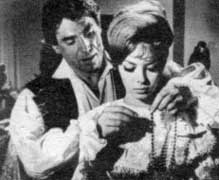 Still, the young man refused at first. It wasn't because of fear, or religious
scruples. He just felt, with the pride of his nobility, that he could, and should, fulfill his destiny in the body
that he had inherited at birth. And the future proved him right. With the help of an understanding, and maybe secretly
admiring, Balsamo, Peyrac learned to overcome most of his handicap, even if he continued to limp and if his face
remained scarred. But he acquired everything that he had dreamed of: riches, knowledge, adventure, and the love
of Angélique, one of the most beautiful
women of his century.
Still, the young man refused at first. It wasn't because of fear, or religious
scruples. He just felt, with the pride of his nobility, that he could, and should, fulfill his destiny in the body
that he had inherited at birth. And the future proved him right. With the help of an understanding, and maybe secretly
admiring, Balsamo, Peyrac learned to overcome most of his handicap, even if he continued to limp and if his face
remained scarred. But he acquired everything that he had dreamed of: riches, knowledge, adventure, and the love
of Angélique, one of the most beautiful
women of his century.
As for Balsamo, he was not old yet, and had plenty of time left to find another man desperate enough to accept
his bargain. He had become a local celebrity and, in 1644, was made a "citizen" of Toulouse. In 1650,
the town council officially dispatched him to fight a plague epidemic that had struck the nearby city of Castres.
Balsamo was around fifty, and knew that he would soon have to find a new body.
In Castres, Balsamo met a Protestant trader, Marius, Count of Rennepont, dying from plague. It was easy to convince him to leave his dying body for that of his physician.
As to Balsamo, he could easily cure the plague which debilitated his new body. Even if Rennepont was only around
ten years younger than he, Balsamo found in his memory a treasure trove of interesting information about the secret
struggle pitting the Jesuits and their
allius from the Compagnie du Saint-Sacrement
against the Rosicrucians, an occult society
well known to the Face-Stealer.
Thus, Marius Rennepont ended his life in Balsamo's former body. The records of the City of Toulouse do not telll
us of his fate after 1650. We do knowm however, that the Face-Stealer, when he still was Joseph Balsamo, had fathered
at least one, possibly several children. Some of offsprings returned to live in Sicily, the land of their ancestors,
and eventually begat the second Joseph Balsamo, a.k.a. Cagliostro. Others converted to Protestantism and emigrated to America -- more about them later.
 Marius Rennepont
Marius Rennepont
One will note here that the Face-Stealer, unlike other immortals, was able to produce offsprings. This was a major
advantage for him, as his direct descendants were completely compatible with his astral physiology in the event
of a soul transfer. In fact, as we will see, he used descendants of his more than once during his various incarnations.
As Marius Rennepont, he had other children, the story of which was reported by Eugène
Sue as having descended from the "Wandering Jew's sister." The Wandering
Jew, according to the legend, was condemned to walk eternally after Christ's death, and wasn't unlike the Face-Stealer:
immortal, keeper of mighty secrets (including the mysteries of the Holy Grail), and, according to some, even able
to change his face. As for his "sister", according to Sue, she too wandered like her brother. In other
versions of the legend, the Wandering Jew had a soul-mate, usually assumed to be Herodias,
Queen of Galilee. All these accounts indicate that the Face-Stealer very likely
had a female companion, who had been with him during some of his incarnations. That woman, who may well have been
Herodias, was then called by the more common name of Madame Rennepont.
 What may have required the presence of Herodias at her soul-mate's side was
that, at that time, the battle between the Jesuits and their allies from the Compagnie du Saint-Sacrement and the
Rosicrucians had intensified. Each side almost succeeded in overthrowing the French king Louis XIV . The Jesuits
had a hand in a failed conspiracy to replace him with his secret twin brother, who was later condemned to wear
an Iron Mask. These events were ably chronicled by Alexandre Dumas in the notorious The Man in the Iron Mask.
What may have required the presence of Herodias at her soul-mate's side was
that, at that time, the battle between the Jesuits and their allies from the Compagnie du Saint-Sacrement and the
Rosicrucians had intensified. Each side almost succeeded in overthrowing the French king Louis XIV . The Jesuits
had a hand in a failed conspiracy to replace him with his secret twin brother, who was later condemned to wear
an Iron Mask. These events were ably chronicled by Alexandre Dumas in the notorious The Man in the Iron Mask.
What is known is that the "new" Marius Rennepont travelled widely throughout Europe, which was justified
by his new occupation as a trader. In Germany, in 1666, seemingly age 46, he met an Irish gentleman called John Melmoth, who looked to be around six years younger
than he was.
We have a first-hand testimony by an Irish parson named Charles Robert Maturin of Melmoth having been struck by some type of coma who caused him to be declared dead . Actually,
his soul was probably travelling in the astral world, which led to an exchange of bodies with Rennepont. We do
not know what might have led John Melmoth to agree to such a trade; we may speculate about his well-known disgust
for his then empty life, his eccentricity and his attraction for the occult. However, his new existence as Marius
Rennepont would mot be lucky. Upon his return to France, he was hunted down by the Jesuits who had not forgotten
the troubles caused for them by the "previous" Marius Rennepont. Eventually, he committed suicide in
1682.
 John Melmoth
John Melmoth
France, by that time, had much changed. King Louis XIV was
firmly established on the throne, even if the Jesuits
were secretly pulling the strings -- which was not to the King's liking. They had, in fact, succeeded in ridding
thenselves of their ancient enemy: the influence of the Rosicrucians had waned. The Compagnie du Saint-Sacrement
had been weakened too, and Louis XIV's secret twin brother was now imprisoned forever behind an Iron Mask.
Some claimed that he ultimately escaped and fathered offsprings, but he was no longer a threat to the crown; the
enemies of Louis XIV were defeated one after the other, and even Joffrey de
Peyrac was forced to live in exile.
Perhaps because of the Jesuits' control of France, the Face-Stealer, now John
Melmoth, chose to avoid France, even though he was at the Castle of Saint-Cloud
when Henrietta Stuart died there in 1670. Melmoth was later reported in England, Spain, England again, and even
in the East Indies. His position grew more uncomfortable. Herodias was no longer at his side anymore; soon, his
new body reached the fifties, and the need to find yet a new fleshy envelope became urgent again.
He preyed upon the hopeless beggars, prisoners of the Spanish Inquisition, etc. In the early 1680s, he tried to
father a son with a young Spanish noblewoman, Doña Isidora -- a son whose body could be a future receptacle for his soul. But the child did not live,
and Isidora died soon after too.
The Wanderer ultimately found the man he was seeking -- a Sicilian nobleman, the Count
of Monteleone (The King of Spain, at that time, reigned over Naples and Sicily.)
Monteleone was the son of an earlier nobleman who had lost and recovered his heritage in dramatic circumstances,
recounted by writer Paul Féval
in Bel Demonio. He may have been in his
thirties when he met the Face-Stealer, and we do not know what convinced him to trade bodies with Malmoth. We only
know that, after he inhabited the physical envelope of John Melmoth, the former Monteleone managed to perfect his
mastery of the techniques of psychic vampirism, and was able to live under the features of a young man for more
than a century thereafter.
 The Count of Monteleone
The Count of Monteleone
As for the Face-Stealer, who now was a man called Monteleone, he reached a high position at the court of the decadent
king of Spain, Charles II. Two sides were
then competing for succession. One was led by the French Duke of Anjou, grand-son of Louis XIV; the other by an
Austrian prince from the House of Hapsburg. The latter was supported by the young queen, the German-born Maria
Anna von Neuburg (1667-1740), whom Charles II had married in 1690.
A 18th century historian refers to the Count of Monteleone as an attendant of the Queen, but in reality, he was probably more than that. Victor Hugo in Ruy
Blas revealed how Maria Anna von Neuburg's lover was an adventurer hiding
under a false name, whom she elevated to the rank of Prime Minister, and who undertook surprisingly good reforms.
We know that the Rosicrucians, with whom the Face-Stealer was allied, were traditional opponents of the Hapsburgs,
who embodied everything they fought against: hegemony over Europe, absolute monarchy, and intolerant catholicism.
One can only wonder and speculate about the role played by Monteleone in the matter of the Spanish succession.
Upon the death of Charles II, in 1700, the Queen's party was defeated. In his will, the King had left his throne
to the Duke of Anjou. The French Prince (ancestor to the current King of Spain, Juan Carlos) took over Madrid.
In 1701, the Spanish Succession War between France and Austria began. Soon, Maria Anna was forced to leave Madrid
and live in exile in Toledo. As for Monteleone, he took refuge in Vienna, where he was warmly greeted as a presumed
champion of the Austrian cause in Spain. The Hapsburgs trusted him enough to let him near a high-ranking political
prisoner: Franz Leopold Rakoczy, heir
to the throne of Transylvania.
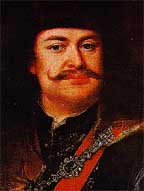 Franz Leopold Rakoczy
Franz Leopold Rakoczy
The young prince (he was born in 1676) had spent a major portion of his life as a hostage of the Austrians, especially
since they had annexed Transylvania in 1698. When war erupted between Austria and France, he was immediately jailed
in the fortress of Wiener-Neustadt. That is where he met Monteleone: a man who offered him the means and energy
to fight for the Transylvanian cause - and freedom. Soon afterwards, it was reported that Franz
Leopold Rakoczy had escaped from Wiener-Neustadt, and that Monteleone had
gone back to Sicily.
Meanwhile, at the end of 1701, the son of the Count of Monteleone and Maria Anna von Neuburg was born in Toledo.
Decades later, a mysterious nobleman, whho was whispered to be the bastard son of the Queen of Spain, or alternatively
Rakoczy's son, began to wander the Courts of Europe as -- the Count of Saint-Germain.
During that time, the man who was now known as Rakoczy fled first to Poland, then to Transylvania. In 1703, that
principality rose against Austria. The revolt engulfed all of Hungary, which Rakoczy proclaimed an independent
state in 1707. The fugitive prince haunted (figuratively speaking!) many a night of the Hapsburgs until 1710. Then,
the rebellion ran out of steam, and without French support (France being itself under assault), Rakoczy was forced
to flee to Prussia.
 In 1714, the Spanish Succession War ended in favor of the Duke of Anjou. Rakoczy
was in France at the time. He purchased in Paris a mansion on the Quai Malaquais which became known as -- the Hôtel de Transylvanie. It was, in fact, the same
place that author Chelsea Quinn Yarbro
would later mistake for Saint-Germain's own Parisian residence . The Hotel was soon known as a place of gambling
and debauchery. It is probably there that, in 1717, Rakoczy met his son, or more accurately, the son of Monteleone
and Maria Anna von Neuburg: Denis, Count of Saint-Germain.
In 1714, the Spanish Succession War ended in favor of the Duke of Anjou. Rakoczy
was in France at the time. He purchased in Paris a mansion on the Quai Malaquais which became known as -- the Hôtel de Transylvanie. It was, in fact, the same
place that author Chelsea Quinn Yarbro
would later mistake for Saint-Germain's own Parisian residence . The Hotel was soon known as a place of gambling
and debauchery. It is probably there that, in 1717, Rakoczy met his son, or more accurately, the son of Monteleone
and Maria Anna von Neuburg: Denis, Count of Saint-Germain.
Being the illegitimate son of a queen, the young nobleman -- he was 16 at the time -- could not hope for a destiny
to match his ambitions. His mother had been forced to leave Spain in 1706, and now livedin exile in Bayonne, in
Southwestern France. Young Saint-Germain had grown up near her, even if the secret of his birth had remained concealed.
Having recognized his father for who he was, possibly confused by the debauchery reigning in the Hotel, young Saint-Germain
agreed to the exchange of bodies suggested by Franz Leopold Rakoczy. Shortly thereafter, the man who was now known
as the Prince of Transylvania left Paris to retrieve his principality.
The "new" Rakoczy went first to Turkey, begging for help, Turkey being The Austrians' hereditary enemy.
Unfortunately, the Turks had just negotiated a treaty of peace with Austria. So, in 1718, they jailed Rakoczy,
who spent the rest of his natural life in captivity, until his death in 1735. His true mother, Maria Anna von Neuburg,
died in 1740. At that time, the fame of the Count of Saint-Germain was growing throughout Europe -- alchemist,
physician, polyglot, musician, painter, secret agent, detective of the occult, rosicrucian and teller of tall tales!
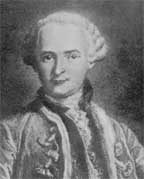 The Count of Saint-Germain
The Count of Saint-Germain
What can be told about Saint-Germain that
has not been said already? Few incarnations of the Face-Stealer impressed their contemporaries more than he. Even
today, crooks and lunatics claim to have met him, or have been in spiritual contact with him, or to be his reincarnation.
His public life was noticeably long -- indeed, the Face-Stealer occupied his body for more than half a century
-- but he seemingly didn't grow old for decades. Some people who met him in Paris during the 1750s, found him seemingly
unchanged since they had last met him in Venice in 1709-1710. It is possible that they had in fact met his biological
father and double: the Count of Monteleone.
A credible testimony is that of Spaniards linked to the secret community of Gomelez, who claimed to have met the
Wandering Jew in 1739, near Granada...
The Face-Stealer first appeared under the name of Saint-Germain in Germany in 1743, during the Austrian Succession
War. The French Marshal Belle-Isle, whom he had cured from a persistent disease, brought him back to France. Paris
then became his main residence, even if he still journeyed widely through Europe, especially to London and Vienna.
It seems that he was a member of the "Secret du Roi" (The King's Secret), a secret intelligence service
created by French King Louis XV, and worked on setting up alliances with England and Prussia. At the time, most
of Louis XV's ministers, including Choiseul, the head of the Foreign Office, and the King's mistress, Madame de
Pompadour, were in favor of seeking alliances with other catholic powers, like the Hapsburg's Austria, not protestant
ones. But the Face Stealer still hated his old enemies, the Hapsburgs...
In 1760, Saint-Germain was in Holland, on one of his secret missions. Choiseul tried to have him arrested. As Louis
XV couldn't officially support him, he was forced to flee, and he was forbidden to return to France for some time.
He travelles to England, Germany, then Russia. One must note that, in 1758, a mysterious woman, presumed to be
French, claiming to be 36 year-old, arrived in Utrecht, Holland. She looked well educated, kept to herself, and
lived on an annuity from the French government. In 1762, her stipend having been suspended, she moved to Amsterdam,
then disappeared. Rumours said that she was related to the Count of Saint-Germain, and was his mistress, or his
wife. Could she have been Herodias?
However, the Face-Stealer would soon find a new consort. In Italy, in 1768, he met the second
Joseph Balsamo and his wife.
 The Second Balsamo
The Second Balsamo
Born in 1743 in Sicily, the second Joseph Balsamo
had showed for years a deep interest in occultism and secret societies, like Freemasonry and the Rosicrucians.
Travelling through Italy, in 1768, he married a young Roman woman with mediumnic powers, Lorenza
Feliciani.
Soon after, Balsamo met Saint-Germain, who was one of the people he admired and envied the most. A German narrative
shows them seemingly battling, but in fact secretly teaming up, during the Carnival of Venice of (c.) 1770. But
it wasn't enough for Balsamo to be only Saint-Germain's assistant. To enjoy the same renown and knowledge than
the famed occultist is what he wanted. For this, he was ready to give up everything -- including his own body.
The exchange was facilitated by the fact that the second Balsamo was, as we saw above, a direct descendent of the
first. As for Lorenza, it seems that she didn't mind the change in her husband's personality.
The man who henceforth continued to be known as Saint-Germain, like the former occupant of his body, pursued his
journeys throughout Europe, protected and richly supported by various princes and heads of state. It is even possible
that he may have met the man who was now Balsamo again. In any event, he died in Germany in 1784.
Or did he?
I already mentioned the fact that the Saint-Germain had not appeared to age for decades. He himself joked about
being several centuries old, claiming that a peculiar regime was the reason for his apparent youth. At other times,
he mentioned a certain elixir which had been given to him by a "Queen of Judea" -- possibly Herodias?
The extent of his youth and longevity lead us to believe that he had been resorting to psychic vampirism. Balsamo,
on the other hand, when he came to take over Saint-Germain's body, was not a master this technique. Like others
before him, in order to avoid age and death, he turned to a more violent and lethal form of vampirism: the way
of blood.
 A word about Saint-Germain and Vampirism
A word about Saint-Germain and Vampirism
One surmises that it is only after the presumed date of the body swap, circa 1770, that the stories about Saint-Germain
and vampirism can be taken seriously. As for the Face-Stealer, it seems that he never resorted to that cruder method
for extending his own life. His attitude towards blood-drinkers was in fact rather ambiguous: sometimes, they were
his instruments; other times, his fierce enemies. The hatred of the Rosicrucians for the Hapsburgs had, in fact,
more than political reasons. Thanks to the research of Tim Powers, we now know that the rulers of Austria had, since the Middle Ages, concluded an alliance
with a race of immortal, shape-shifting, vampiric creatures, known as the Nephilim.
It is interesting to note that Madame de Pompadour
and her only daughter, Alexandrine, showed
definite signs of a possession by the Nephilim, as such is described by Powers. Madame de Pompadour died from a
long and mysterious illness in 1764, at the age of 43. Her daughter had also died from unknown causes in 1754.
She had been engaged to the young Duke of Chaulnes
(1741-1792), who later left his family and estate to travel to Egypt, where he dedicated himself to archaeology
around the mysterious pyramid of Sakkara. After his return to France, he lived in seclusion, apparently devoted
to scholarly research, and died young. As to the Face-Stealer, some believe that Lorenza, Balsamo's wife, was not
only a medium but also a victim of vampirism.
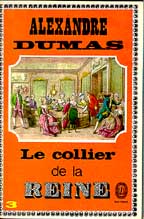 Cagliostro
Cagliostro
Now, the Face-Stealer turned against the French monarchy. (Other Rosicrucians were presumably acting against the
Hapsburgs.) During his travels through Europe, especially during the two long stays in Paris, from 1770 to 1774,
and from 1785 to 1786 - the later under the new alias of Count Cagliostro - he became a major agent laying the ground works for what would become known as - the French
Revolution.
Cagliostro was at the centre of a vast conspiracy, of which the Rosicrucians were only one element. The pseudo-masonic
lodge that he founded was part of his web, and a way to seduce the frivolous nobility and upper middle class of
his times. All this was reported in detail by Alexandre Dumas in his works, Joseph Balsamo
and The Queen's Necklace.
On 29th July 1788 was born Joséphine Balsamo,
the daughter of Joséphine de Beauharnais
(1763-1814), the future empress of the French emperor Napoleon -- Joséphine was at that time separated from
her first husband, the Count of Beauharnais.
By the time of her birth, her father, who had finally been expelled from France after the Necklace Affair, had
resumed his wanderings throughout Europe with Lorenza. His latest stays in France were undercover. It is probably
during one of these trips, in 1789, that a body exchange was made with Abbot
Faria.
 Abbot Faria
Abbot Faria
José Custodio de Faria was born
in 1756 near Goa, in the Portuguese Indies. A half-breed, son of a Brahman woman, he was taken by his father to
Lisbon at the age of 15. He studied theology and took the Holy Orders in Rome in 1780. After some years spent in
the Ministry in Portugal, he settled in Paris in 1788. Like young Joseph Balsamo, twenty years before, he was deeply
fascinated by the occult, and especially by Franz Anton Messmer's (1734-1815) theories of magnetism, which were at the time spreading through Europe. Mesmerism
may have played a role in the soul transfer which was performed while the French Revolution was starting.
Faria, now living inside Cagliostro's body, did not use his new body and identity wisely. He and Lorenza settled
in Rome, which was just about the last thing to do for a man who was widely knownto be a dedicated opponent of
the Catholic Church. Furthermore, Lorenza was unhappy with her new husband. Towards the end of 1789, she reported
him to the Inquisition. The Roman archives report that a Joseph Balsamo, Count
of Cagliostro, was sentenced to perpetual imprisonment, and died in jail in
1795. As for Lorenza, who had been secluded into a convent, there is no known report of her death. It must however
be remembered that she had, some years before, received the vampiric kiss...
Meanwhile, the man who now bore the face and name of Abbot Faria was living in Paris. Strangely enough, in spite of being a Catholic priest, a foreigner, and
an occultist, he was never bothered during the Reign of Terror. He nevertheless took part in the plot which led
to the evasion in 1794 of young Louis XVII, son of the guillotined king Louis XVI. (The official version is that
he died in jail in 1795, at the age of 10.)
 The prime mover behind this plot was Sir Percy Blakeney, a.k.a, the Scarlet Pimpernel (1760-1823?).
Another plotter was the Swedish officer Hans Axel von Fersen (1755-1810), who had been deeply in love with Louis XVII's mother, the late queen Marie-Antoinette. Some historians hypothesize that he
could have been the young king's father. Marie-Antoinette's lover was the son of Frédéric
Axel von Fersen (1719-1794), and his mother was Hedvige
Eléonore Delagardie (1732-1800), from a noble French family, a branch
of which had settled in Sweden two centuries prior.
The prime mover behind this plot was Sir Percy Blakeney, a.k.a, the Scarlet Pimpernel (1760-1823?).
Another plotter was the Swedish officer Hans Axel von Fersen (1755-1810), who had been deeply in love with Louis XVII's mother, the late queen Marie-Antoinette. Some historians hypothesize that he
could have been the young king's father. Marie-Antoinette's lover was the son of Frédéric
Axel von Fersen (1719-1794), and his mother was Hedvige
Eléonore Delagardie (1732-1800), from a noble French family, a branch
of which had settled in Sweden two centuries prior.
Blakeney and Fersen probably agreed to entrust the young fugitive to the care of some British relatives. That's
how young Louis came to spend some time with Honoré Delagardie and his wife, Philippa Drummond.
This couple and the Blakeneys, as everyone knows, were among the people who attended the Wold
Newton meteoritic encounter, on the 13th of December 1795.
What about Louis XVII? Where was he on this historical day? Some historians have speculated that Freemasons and
Rosicrucians, such as Abbot Faria, had been deeply interested in the young king's escape and his ultimate fate.
Certainly, both his alleged fathers, Louis XVI and Hans Axel von Fersen, were high-ranking Freemasons, and Masons
owe assistance to their masters' children when they are in danger. Such children are called, in the terminology
of Freemasonry, the "sons of wolves" -- or, in French, "louveteaux"-- or "lupins"! (from the Latin "lupus" = wolf).
 This makes us immediately think of the notorious Arsène
Lupin, which showed several times (like in The
Hollow Needle), his knowledge of and interest for the secrets and treasures
of French monarchy.
This makes us immediately think of the notorious Arsène
Lupin, which showed several times (like in The
Hollow Needle), his knowledge of and interest for the secrets and treasures
of French monarchy.
Therefore, I will hypothesize that Arsène's ancestor, Louis Lupin, manservant of the Delagardies, who according to Philip
José Farmer attended the Wold Newton encounter, was none other than
Louis XVII, by that time 10 years-old
and living at the Delagardies' under the guise of a servant.
The young king was, of course, an important instrument in the schemes put in motion by the Conspiracy, of which
the Wold Newton encounter was only one episode.
Unlike what is stated in Jean-Marc Lofficier's
article, Will There Be Light Tomorrow?, "Louis Lupin" (Louis XVII) wasn't related to Napoleon
Bonaparte, although it is worth noting that Napoleon's second wife, Marie-Louise of Austria, was a niece of Marie-Antoinette,
hence a first cousin of Louis XVII.
In the conspiracy which enabled Napoleon to seize power, the young king was an extra, secret card, held in reserve,
by the Conspirators, of which Abbot Faria was surely one. Of course, Napoleon achieved a great part of the Rosicrucians'
program, and definitively took Germany away from the Hapsburgs; he also crushed the power of the Jesuits, and even
placed the pope under house arrest in Rome. But, when he ran out of control, the Conspirators had at hand a legitimate
pretender to the throne, one sympathetic to their cause.
A Word about Louis Lupin's Offsprings
Another person who looked on Louis Lupin
as a potential ally was Joséphine de Beauharnais
herself. The Face-Stealer, using the alias of Faria, had made himself known to her as her lover of old. Having
produced no sons to Napoleon, she felt in danger of being repudiated, which actually occurred in 1809. She belonged
to the old French nobility, and wasn't opposed to a new monarchy in which she could still play a role.
 Faria
and Joséphine found a way to secure their influence on the young king, Louis Lupin (as we shall now call
him) by pushing him into the bed of their daughter, Joséphine Balsamo. Joséphine Balsamo II,
the child of Joséphine Balsamo and Louis Lupin, was probably born around 1805. It is probably her, and not
her mother, who became the companion of Roland Richmond de Valgeneuse, and thus was the mother of Rocambole, who was born around 1826-1827.
Faria
and Joséphine found a way to secure their influence on the young king, Louis Lupin (as we shall now call
him) by pushing him into the bed of their daughter, Joséphine Balsamo. Joséphine Balsamo II,
the child of Joséphine Balsamo and Louis Lupin, was probably born around 1805. It is probably her, and not
her mother, who became the companion of Roland Richmond de Valgeneuse, and thus was the mother of Rocambole, who was born around 1826-1827.
Rocambole's physical description matches that of young Louis XVII: height slightly under the average, thin, light
chestnut hair, blue-grey eyes, "Austrian lip" (that is, a pouting mouth, characteristic of Marie-Antoinette's
ancestors). Some researchers claim that, at his birth, Rocambole was christened "Ferdinand Joseph", which
of course were hereditary names in Marie-Antoinette's family -- yet another clue to his true lineage.
 Louis Lupin, like his ancestors Louis XIV and Louis XV, sired several children by his first wife, Pascaline de Felipone. He was obviously not the biological
father of Charles Delagardie, the son
of Honoré and Philippa Drummond: the child was born only some months after the Wold Newton encounter, while
Louis Lupin was only 10 or 11 years-old. He nevertheless adopted him after his parent's warly death, giving him
a new family name, identical with his own but for an initial D, supposedly reminding of "Delagardie".
Charles Dupin would become the father
of the great detective Charles-Auguste Dupin,
celebrated by Edgar Allan Poe. This name
was intended to hide the real and royal origins of Charles and Charles-Auguste. Nevertheless, their offsprings
preferred reverting to the initial "L" and the name "Lupin,"" as its symbolic value was
too great to be casually discarded.
Louis Lupin, like his ancestors Louis XIV and Louis XV, sired several children by his first wife, Pascaline de Felipone. He was obviously not the biological
father of Charles Delagardie, the son
of Honoré and Philippa Drummond: the child was born only some months after the Wold Newton encounter, while
Louis Lupin was only 10 or 11 years-old. He nevertheless adopted him after his parent's warly death, giving him
a new family name, identical with his own but for an initial D, supposedly reminding of "Delagardie".
Charles Dupin would become the father
of the great detective Charles-Auguste Dupin,
celebrated by Edgar Allan Poe. This name
was intended to hide the real and royal origins of Charles and Charles-Auguste. Nevertheless, their offsprings
preferred reverting to the initial "L" and the name "Lupin,"" as its symbolic value was
too great to be casually discarded.
Some claim that the former king eventually spent the last portion of his life under the name of Charles Allard, provided by Sir Percy Blakeney. Under
that name, he married his second wife, Philippa de Courcy,
who gave him no less than twelve children . Even scattered throughout the world, the Balsamos, the Lupins and the
Allards would occasionally meet, as those who have read Jean-Marc Lofficier and Lynx412's studies
now know.
A Treasure Hunt Begins
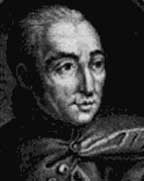 As for Abbot Faria, he continued
to live in Paris. Circa 1802, he met the writer Restif de La Bretonne, who published in this same year Les Posthumes. In it, we meet the fictitiously-named character of the "Duke
Multipliandre", capable of transferring his soul into the body of another
person, even on other planets and in the future. These last powers appear to have exceeded the capabilities of
the Face-Stealer, but remind us of the Great Race of Yith
described by H.-P. Lovecraft. This could,
in fact, be a clue as to how the Face-Stealer discovered the technique of soul transfer, and acquired his own powers.
As for Abbot Faria, he continued
to live in Paris. Circa 1802, he met the writer Restif de La Bretonne, who published in this same year Les Posthumes. In it, we meet the fictitiously-named character of the "Duke
Multipliandre", capable of transferring his soul into the body of another
person, even on other planets and in the future. These last powers appear to have exceeded the capabilities of
the Face-Stealer, but remind us of the Great Race of Yith
described by H.-P. Lovecraft. This could,
in fact, be a clue as to how the Face-Stealer discovered the technique of soul transfer, and acquired his own powers.
Soon, a new and more important matter relegated the case of Louis XVII to the background -- no less than a second
quest for the Holy Grail.
I won't attempt to define precisely what the Holy Grail is or was: alien artefact, magic stone, a place, a ritual,
or even a special gene inherent in the blood of some people, said to be descended from Christ. I shall merely speculate
that the Grail, as its image appeared to King Arthur, is in fact linked to the mystery of Wold Newton.
It is indeed difficult to imagine a time and a place, in the entire western world's history, when the emergence
of extraordinary people and extraordinary events was as profound and everlasting as at Wold Newton. Yet, one can
make that case about Arthurian England.
The Scottish Stuarts, claiming to be descendants of King Arthur, also claim to have been in possession of the secret
of the Holy Grail. New research shows that this secret is also connected to that most mysterious of characters
-- the man known to us as the Count of Monte-Cristo!
 According
to what Alexandre Dumas tells us about
the origins of the Count's vast fortune, the treasure of Monte-Cristo came, via information provided by Abbot Faria,
from an old Italian family, the Spadas,
whose last member, a cardinal, had died in Rome in 1807. Coincidentally, also in 1807, also near Rome, died Cardinal
Henry of York, last of the legitimate
Stuarts.
According
to what Alexandre Dumas tells us about
the origins of the Count's vast fortune, the treasure of Monte-Cristo came, via information provided by Abbot Faria,
from an old Italian family, the Spadas,
whose last member, a cardinal, had died in Rome in 1807. Coincidentally, also in 1807, also near Rome, died Cardinal
Henry of York, last of the legitimate
Stuarts.
Henry of York's secret was known to two men: one, his old Italian secretary; and the other, the heir to an illegitimate
branch of the Stuarts, the Fitzroys de Clare.
This family counted, among its ancestors on the distaff side, the Sinclairs
of Roslin from Scotland, and the Saint-Clairs from Normandy, who were companions of William the Conqueror, and who had, for generations,
been charged with the secret of the Grail. This explains that the destinies of some members of that family (including
the Nyctalope,
Lord Lister, Brett
Sinclair, and others) are worthy of the Wold Newton families.
However, the Sinclairs were thwarted in their quest for the Grail and Henry of York's treasure by two powerful
forces: One was Napoleon, whose police
quickly arrested the Italian secretary and sent him to the Château d'If; the other was the Italian Camorra.
The Immortal Godfather
Resettled in Italy under the name, and in the body of the Count of Monteleone, the man who had once been Franz Leopold Rakoczy, had undertaken to build a new empire to
replace the Transylvania he had lost to the Hapsburgs, this time a criminal empire.
Using the memories of his body's former occupant, he found himself able to master the technique of soul transfer.
Throughout the 18th century, he exchanged bodies several times. During the 1780s, he encountered the secret son
of Fernando I, King of Naples, and Countess Fiorentina Pierni. Young Fernando
Pierni (born 1768) and his mother had been the victims of the king's new mistress,
the Duchess of Malfiera. The Countess had been poisoned, and her son abducted and shipped by force on a corsair
ship. The desperate teenager proved himself ready and eager to trade his body with Monteleone, provided that that
the latter would seek vengeance against his tormentors. In the 1790s, Fernando Pierni, now at the head of a powerful
criminal organization, plundered Southern Italy under the name of the Black
Eagle.
At the end of the same decade, he exchanged bodies with a bandit promised to the Napolitan gallows: Michele Pezza, born around 1771 and known as Fra Diavolo. Under that name, he took part in the resistance
against the French invasion of 1799, acquiring some kind of respectability and even being made a colonel by the
king of Naples. The newly-appointed Colonel Pezza, however, did not forget the needs of his criminal empire, which
he had delegated to Mario of Monteleone,
a descendant of the Count whose body he had occupied long ago. He himself chose to stay behind the scenes, operating
in a series new bodies: that of the German adventurer David Heimer (born in 1782), one of Monteleone's main assistants. As for the man who had traded that body,
if he had hoped to acquire the power and fame of Fra Diavolo, he was sorely disappointed: when the French troops
again invaded the kingdom of Naples, Fra Diavolo was captured and hanged. The year was 1806.
 The new David Heimer soon understood that the Napolitan Camorra, especially under the Napoleonic occupation,
wasn't large enough to enable him to find the Holy Grail, as he noew planned to do. He needed to build a more powerful
international organisation, especially in France, where the old Italian Secretary was still detained, and where
the Fitzroys de Clare were living.
The new David Heimer soon understood that the Napolitan Camorra, especially under the Napoleonic occupation,
wasn't large enough to enable him to find the Holy Grail, as he noew planned to do. He needed to build a more powerful
international organisation, especially in France, where the old Italian Secretary was still detained, and where
the Fitzroys de Clare were living.
He finally achieved his goals when he traded bodies with an older Corsican operative, likely born c. 1739, the
Colonel Michel Bozzo-Corona. Thus did
the Immortal Godfather began to rule the underworld of Europe, fist from Sicily, then from Corsica, then on the
continent. The similitude of ranks and names -- Colonel Michele Pezza, Colonel Michel Bozzo -- prove that this
was just another fake identity, meant to remind the underworld that their ruler was still the man who had been
Fra Diavolo. His organisation would become known as -- the Black
Coats.
The history of the Black Coats has been thoroughly researched by Paul Féval, yet many chapters remain shrouded in obscurity. Mario Monteleone allegedly died in 1815.
Curiously, the first Monteleone, the man who had once traded his body to the Face-Stealer and was now wandering
the world as John Melmoth, also vanished
mysteriously in Ireland the following year. Yey, it is known that he reappeared in Paris a few years later, but
in his body or that or another? As for Corona/David Heimer, his attempts to lay claim to the Monteleone heritage
also led him to his death, in 1823.
The Prisoner of the Château d'If
Meanwhile, during the years 1811-1812, the Face-Stealer, still using the identity of Faria, was teaching philosophy
at Marseilles' High School, knowing full well that Cardinal Stuart's former Italian secretary was detained at the
Château d'If. One can only speculate as to how Faria gained access to the secretary's gaol, as Melmoth had
done with the Inquisition's prisoners decades before. However, the prisoner received him with open armns and embraced
the proposed body swap. Leaving the Château d'If as José Custodio de Faria, he spent the last years
of his life in Paris, where he died in 1819.
 But
even though the Face-Stealer had found the secrets he was seeking in the Italian's memory, he was now prisoner
at the Château d'If, unable to profit
from his new knowledge! He had to wait until he could make contact with a new prisoner: a young sailor from Marseilles,
Edmond Dantès (born 1796), who
had been unjustly imprisoned in 1815 for political reasons.
But
even though the Face-Stealer had found the secrets he was seeking in the Italian's memory, he was now prisoner
at the Château d'If, unable to profit
from his new knowledge! He had to wait until he could make contact with a new prisoner: a young sailor from Marseilles,
Edmond Dantès (born 1796), who
had been unjustly imprisoned in 1815 for political reasons.
To make Dantès accept the transfer of souls needed years of persuasion, until Faria finally convinced Danteès
was he, with his superior powers and knowledge, was better equiped to revenge Dantès, and help his loved
ones. After the transfer was made, Dantès died in Faria's aged body, from a both physical and psychological
aftershock, and the Face-Stealer escaped soon after in Dantès body. In the year 1829, he was free again,
in the young body of Edmond Dantès, who would soon be known under the name of Count
of Monte-Cristo. The Quest of the Holy Grail was on again.
Arthur Gordon Pym
The Face-Stealer added to the knowledge that he had acquired from the Italian secretary what he learned from a
sailor he met soon afterwards: Arthur Gordon Pym
of Nantucket.
 Unlike what Jean-Marc Lofficier
states in his article Who Was Nobody?, I do not think that the Arthur Gordon Pym whom we meet in the narrative transcribed by Edgar Allan Poe, and who sailed in the Antarctic during
the years 1827-1828, could have been Joseph Balsamo, a.k.a. Cagliostro. This Arthur Gordon Pym was a young man,
with the feelings, the behavior, and reactions of a young man, and I can't imagine him as being several centuries
old -- no more than I could, say, imagine Tom Sawyer
being that old either.
Unlike what Jean-Marc Lofficier
states in his article Who Was Nobody?, I do not think that the Arthur Gordon Pym whom we meet in the narrative transcribed by Edgar Allan Poe, and who sailed in the Antarctic during
the years 1827-1828, could have been Joseph Balsamo, a.k.a. Cagliostro. This Arthur Gordon Pym was a young man,
with the feelings, the behavior, and reactions of a young man, and I can't imagine him as being several centuries
old -- no more than I could, say, imagine Tom Sawyer
being that old either.
Nevertheless, the etymology of his family name, as researched by Mr. Lofficier, proves that he was indeed a direct
descendant of the first Joseph Balsamo,
likely one of the offsprings of the branch of the family that had emigrarted to America. Further, the Pym family
was well established in Nantucket as early as the end of the 18th century. A whaling captain Noah
Pym (born 1739) spent the 1780-1781 winter in Alaska. Shortly before being
killed by Russian pirates, he had a love affair with a native woman, which could lead us to an Inuk descent of
Joseph Balsamo!
Our Arthur Gordon Pym, born in 1809, was not more than 18 years-old when he sailed to the Antarctic. His narrative
stops some months later, as with his mate Dirk Peters,
he is about to discover the lost and mighty pre-Atlantean civilisation of Dzyan.
What happened afterwards? They were probably taken prisoners. Then, for whatever reasons, the Dzyan played with
them the same sadistic games than their kin, the People of K'n-yan, had played three centuries before with Panfilo de Zamacona
y Nunez (as was reported by H.-P. Lovecraft
& Z. Bishop in The Mound). When, some weeks, months or years later, Arthur Gordon Pym managed to escape from the city
of the Dzyan, his body and Dirk Peter's soul were dead, and his soul was imprisoned in the body of Dirk Peters.
He sailed for some time under that name. Then he encountered the "new" Edmond Dantès, maybe by
chance of unfathomable purpose. In exchange for what Pym had learned from the Dzyan, the Face Stealer taught him
how to master the methods of soul transfer, thus enabling him to free himself.
The Wandering Jew, The Black Coats and Monte-Cristo
Pym did not use his new-found powers right away; instead, he chose to accompny the Face-Stealer (again known as
the Wandering Jew) for some time. Both traveled widely throughout the world.
Herodias returned in the Face-Stealer's life. Together, they fought the Jesuits and the Indian Thuggees, who each
were trying to exterminate the Renneponts and lay hands on their fortune. Knowing what dark forces weres behind
the Thuggees, one can speculate that this treasure was not only physical. They survived the terrible cholera epidemic
of 1832. Thanks to the last surviving Rennepont, both Jesuits and Thuggees were defeated.
Meanwhile, the same epidemic severely struck the de Clare:
the widowed duchess died and her son, who should have been the head of the family, disappeared . Thus began the
long struggle of the Black Coats, who would try for more than twenty years to seize the de Clare treasure and secret.
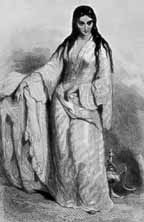 Did
the Face-Stealer take part in that titanic struggle? In 1838, he was back in Paris under the name of Monte-Cristo. With him was Herodias, who had recently
acquired a new appearance, that of Haydée.
The real Haydée, a young and hopeless Turkish slave (born ca 1818), had been longing for a vengeance against
the man who had betrayed her family, and had gladly abandoned her body to the immortal woman in return to revenge.
The Face-Stealer and Herodias did fulfill both Edmond Dantès and Haydée's vows of revenge, while
finding opportunities to trade new bodies for old.
Did
the Face-Stealer take part in that titanic struggle? In 1838, he was back in Paris under the name of Monte-Cristo. With him was Herodias, who had recently
acquired a new appearance, that of Haydée.
The real Haydée, a young and hopeless Turkish slave (born ca 1818), had been longing for a vengeance against
the man who had betrayed her family, and had gladly abandoned her body to the immortal woman in return to revenge.
The Face-Stealer and Herodias did fulfill both Edmond Dantès and Haydée's vows of revenge, while
finding opportunities to trade new bodies for old.
Young and delightful Valentine de Villefort
(born 1816), dying a victim of the poison administered by her stepmother, was rescued by Monte-Cristo after a faked
death. She gave up willingly, maybe with a little help from the special brand of hypnosis practiced by the Count,
her body to Herodias. Soon after, her lover, Maximilien Morrel (born 1807), heart-broken by the news of his fiancée's alleged death, was lured by
Monte-Cristo to his island. Weakened by hashish, he was eagerly willing to change bodies with the Count.
Then, the two couples: Monte-Cristo and Haydée, Maximilien and Valentine, left Monte-Cristo island, each
in the other's bodies, and remained separated for some time. This would account for the contradictions in two later
biographies of Monte-Cristo. According to one, Maximilien and Valentine settled in India, and were murdered during
the Great Mutiny (1857-1858), with the Count outliving them. According to another, Haydée and the Count
died in India soon after the Mutiny, and were outlived by the Morrels. In reality, Maximilien and his wife, now
under the appearances and names of Count and Countess of Monte-Cristo, bought the Sultanate of Ghoulpore in Indian
Kashmir. The Countess was murdered there in 1859 by Sepoy deserters from the Great Mutiny, led by Benedetto, Monte-Cristo's nemesis. The Count ended his
life as an hermit.
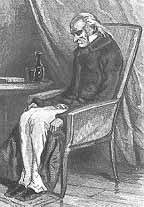 He and his wife had had several children . As for the pair now called Maximilien and Valentine Morrel,
they shared their time between France, Monte-Cristo island, and India. The Face-Stealer kept an eye on the activities
of the Black Coats. In 1841, Colonel Bozzo
got rid of his old body - he was now 103! His new body was that of his own grand-son, Julian
Bozzo-Corona, born around 1801. He did not hesitate to murder his former body
and, keeping the appearance of the old Colonel thanks to a clever disguise, continued to rule the Black Coats with
a hand of steel. Their last attempt to seize the de Clare's treasure, in 1853, failed again, but Monteleone escaped.
He and his wife had had several children . As for the pair now called Maximilien and Valentine Morrel,
they shared their time between France, Monte-Cristo island, and India. The Face-Stealer kept an eye on the activities
of the Black Coats. In 1841, Colonel Bozzo
got rid of his old body - he was now 103! His new body was that of his own grand-son, Julian
Bozzo-Corona, born around 1801. He did not hesitate to murder his former body
and, keeping the appearance of the old Colonel thanks to a clever disguise, continued to rule the Black Coats with
a hand of steel. Their last attempt to seize the de Clare's treasure, in 1853, failed again, but Monteleone escaped.
The offsprings of the de Clare, Saint-Clairs and Sinclairs could henceforth live in relative peace, eventually inclusing prominent characters such as
the Nyctalope,
attorney Jacques Sainclair, who grew up
to become Rouletabille's
confidente, John Sinclair a.k.a. Lord Lister,
Brett Sinclair, and others as well in
France as well as in England.
As to Gabriel Rennepont, heir to the Wandering
Jew, he emigrated overseas after Louis-Napoleon Bonaparte's coup d'état in 1851. It is likely that he and
his friends, among whose was Prince Rodolphe of Gerolstein, later enewed their acquaintances with the Face-Stealer, under his next identity.
Under the names of Maximilien and Valentine Morrel, the Face-Stealer and Herodias had at least one son, Albert, born 1839. He and Laksmi, the daughter of Monte-Cristo (born 1843), became engaged in 1859. In this same year, the
Face-Stealer changed bodies again.
He had always been in touch with the leaders of the Great Indian Sepoy Mutiny, even if he had refused to help them
directly. After the crushing of the revolt, he rescued one of them: Prince
Dakkar (born 1819). Pursued by the English, the Prince had lost his family,
estates and hopes during the Great Mutiny. He gave to his rescuer the only material thing which still belonged
to him -- his body -- then retired to a Tibetan lamasery, where he died in 1861. The rejuvenated Face-Stealer left
clandestinely India, and the story of Captain Nemo
began.
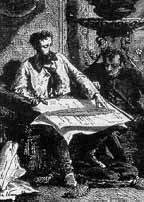 Captain Nemo
Captain Nemo
There are already so many contradictory versions of the history of the man known as Captain
Nemo that I shall just contribute my version.
Thanks to the knowledge he had acquired during his former incarnations, and with the interested help of the Thuggees,
of whom he would get rid as soon as possible, the Face-Stealer, now Captain Nemo, managed to build two submarines.
One of them was stolen by James Moriarty,
who would use for the purpose of piracy and become the second Captain Nemo. The other, commanded by the Face-Stealer
in the body of Prince Dakkar, sailed in the early 1860s. It is during that period, and not in 1867-1868, as Jules Verne would claim later, that he met Professor Arronax and Ned
Land.
Captain Nemo and his crew were eventually doomed by the radiations given of by the Nautilus' engine, due to a sabotage
perpetrated by Moriarty. Soon, the seamen were decimated, even though Nemo had the good sense and humanity of disembarking
many of them. However, when he reached his secret base in the Pacific, situated by roughly 152° W and 37°
S, which would later be christened Lincoln Island, he was alone and dying.
That is when engineer Cyrus Smith ("Cyrus Harding" in the English version) and his companions crashlanded
on the island. In my opinion, that event did take place in 1865, the last year of the American Civil War., and
it is Verne's earliert narrative which is conveniently post-dated.
A half-dead Cyrus Smith was rescued by Captain Nemo. His body wasn't much younger than Prince Dakkar's (he was
born in 1820), but he was of course not contaminated by the radiations. In gratitude for saving his life, and in
exchange for knowledge and help for his companions, he agreed to trade bodies with Nemo. Cyrus Smith would live
three years more, among the riches of the Nautilus. He and the Face-Stealer only met again at the moment of his
death. In 1868. Lincoln Island was already the subject of periodic volcanic activity. Thanks to Nemo's foresight,
the castaways were rescued in 1869, only days after the eruption.
Using the riches brought from the Nautilus, the Face-Stealer and his companions undertook important scientific
and industrial work; as early as 1870, a new Nautilus was sailing. It was probably her captain who took part in
the League of Extraordinary Gentlemen
adventures.
Since then...
Jean Marc Lofficier already made some
educated guesses about the Face Stealer's subsequent identities and activities in his article Who Was Nobody?. Surgical techniques improved in the
1860s thanks to the research of Victor Frankenstein III, and in the 1900s due to the prodigious Germano-American
scientist Cornelius Kramm,
techniques which made body swapping easier.
Defending the Rosicrucian goals, fighting against Monarchs and the Catholic Church, using the French Monarchy then
toppling it in turn, helping the rise of new powers, like the British Empire and later the USA; searching for the
Grail, the knowledge of the Dzyan, and maybe other forgotten sciences from Central Asia, developing powerful new
technologies.... whatever utopian goals the Face-Stealer is pursuing, it is likely that his quest still continues
nowadays.
The third Captain Nemo
In the meantime, Arthur Gordon Pym, having
stood for some time by the Face-Stealer's side, returned to the US in 1836, still wearing the body of Dirk Peters.
We don't know very much about the young American who accepted in 1838 to leave him his body, except that his name
may have been Harold Duggard.
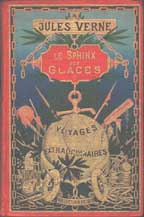 Now in the aging body of Dirk Peters, Duggard undertook another trip to the
Antarctic, where he hoped to meet the Dzyan, and learn the mind-transfer techniques. This expedition only led him
to his death, soon after having discovered the remains of what had been Arthur Gordon Pym's original body near
the Sphinx of the Ice Fields.
Now in the aging body of Dirk Peters, Duggard undertook another trip to the
Antarctic, where he hoped to meet the Dzyan, and learn the mind-transfer techniques. This expedition only led him
to his death, soon after having discovered the remains of what had been Arthur Gordon Pym's original body near
the Sphinx of the Ice Fields.
The former Nantucket sailor had learned a lot during his earlier sojourn among the Dzyan, and later at Monte-Cristo's side. After the American Civil War, he
was ready to launch his own submarine. This was the third Nautilus -- Moriarty's being sunk in the Maelstrom in
1868, and Prince Dakkar's during the cataclysm of Lincoln Island in 1869. Arthur Gordon Pym, or Harold Duggard,
would thus become the third Captain Nemo.
During his travels, he had the opportunity of visiting some ruins of ancient civilisations, the existence of which
he had discovered before. Namor, his son
by Princess Fen of the Deep Ones, was
born around 1870. The third Captain Nemo then settled in Tartessos, a colony of ancient Atlantis, located in Africa, where he had two other children with an
Atlantean princess. Neo was born in 1870,
and Nadia on 31th May 1875.
In the following year, an violent revolt, staged by a party called "New Atlantis", led to the destruction
of Tartessos. Nemo saw his wife die, became
separated from his children, and escaped by miracle. During the following years, he rebuilt a secret base in Antarctica,
wandered through the seas, preparing his revenge against New Atlantis. In 1885, a Captain Nemo helped the wizard
Robert Craven to defeat the Great Old One Dagon but we cannot be sure whether he was
the first Nemo, alias the Face-Stealer, or the third one, alias Arthur Gordon Pym.
On June 24th, 1888, a new, larger and faster submarine - the fifth Nautilus, if we take into account the fourth,
built by the survivor of Lincoln Island - was launched from Nemo's Antarctic base. The final struggle between him
and New Atlantis took place in 1889-1890. The annihilation of his enemies cost him his own life and that of his
son.
Some months later, his last child was born from a young Atlantean named Electra. As for Nadia, she married a young French engineer, Jean
Roch de Lartigue, and had a son. It is qyite likely that Arthur Gordon Pym's
descendants are still, today, navigating the Nautilus.
BIBLIOGRAPHY
(Note: works marked with an asterisk *
are only relied on by secondary readings.)
HISTORY AND PSEUDO-HISTORY
Robert Ambelain
- La Chapelle des Damnés. La Véritable Affaire des Poisons 1650-1703 [The
Chapel of the Damned. The True Affair of the Poisons], Paris, Robert Laffont
1983
- Crimes et Secrets d'Etat 1785-1830 [State Crimes and State Secrets], Paris, Robert Laffont 1980
- Capet lève-toi… Ce que l'on nous dissimulait sur la survie de Louis XVII [Stand
up, Capet. What was Hidden from to us on the Survival of Louis XVII], Paris,
Robert Laffont 1987
Dictionnaire de Biographie Française, articles "Chaulnes" and "Faria"
Roger Facon
- Les Dossiers Secrets de Maurice Leblanc, Père d'Arsène Lupin [The
Secret Files of Maurice Leblanc, Father of Arsène Lupin], Bruxelles,
Editions Savoir pour Etre 1994
Gérard Galtier
- Maçonnerie égyptienne, Rose-Croix et néo-chevalerie [Egyptian
Masonry, Rosicrucism and Neo-Knighthood], Monaco, Editions du Rocher 1989
Laurence Gardner
- Bloodline of the Holy Grail, Element Books 1996
Jean Moura & Paul Louvet
- Saint-Germain, le Rose-Croix immortel [Saint-Germain, the Immortal Rosicrucian], Paris, Gallimard 1934
Jean Robin
- Le Royaume du Graal. Introduction au Mystère de la France [The Kingdom
of the Grail. An Introduction to the Mystery of France], Paris, Guy Trédaniel
1992
Targe
- Histoire de l'Avènement de la Maison de Bourbon au Trône d'Espagne [History
of the Accession of the House of Bourbon to the Throne of Spain], Paris, Saillant
et Nyon 1772
Johannes Van Aken
- Histoire Vraie du Vampirisme [A True History of Vampirism], Genève, Famot 1984
FRENCH FICTION
Honoré de Balzac
- * Melmoth Réconcilié, Werdet 1836
Alexandre Dumas
- * Le Vicomte de Bragelonne [The Man in the Iron Mask],
1847-1850
- * Joseph Balsamo, 1846-1848
- * Le Collier de la Reine [The Queen's Necklace],
1848-1850
- Le Comte de Monte-Cristo [The Count of Monte-Cristo],
1844-1845
Paul Féval,
- * Bel Demonio, 1850
- Les Compagnons du Silence [The Companions of Silence],
1857
- Les Habits Noirs [The Black Coats],
1863-1875
P. G. Gheusi
- La Fille de Monte-Cristo [The Daughter of Monte-Cristo],
Paris, SEPE 1948
Anne et Serge Golon
- Angélique, Marquise des Anges [Angélique, Marquise of the Angels], Paris, Colbert 1957 (and sequels)
Victor Hugo
- Ruy Blas, 1838
Edmond Ladoucette
- Le Masque de Fer [The Man in the Iron Mask],
1880 (and sequels)
Jules Lermina
- Le Fils de Monte-Cristo [The Son of Monte-Cristo],
L. Boulanger 1881
Gustave Le Rouge
- Le Mystérieux Docteur Cornélius, 1912-1913
Gaston Leroux
- Chéri-Bibi, 1913 (and sequels)
Michel Morphy
- Mignon, Paris, Geoffroy 1896 (and sequels)
Jean d'Ormesson
- Histoire du Juif Errant [A History of the Wandering Jew],
Paris, Gallimard 1990
Pierre-Alexis Ponson Du Terrail
- Rocambole, 1857-1870
Jean Potocki
- Manuscrit trouvé à Saragosse [Manuscript Found in Zaragoza], Paris, José Corti 1989
Nicolas-Edme Restif de La Bretonne
- * Les Posthumes [Posthumous Letters],
1802
Eugène Sue
- Le Juif Errant [The Wandering Jew],
1844-1845
- Les Mystères du Peuple [The Mysteries of the Working Class], 1849-1857
Jules Verne
- 20 000 Lieues sous les mers [20 000 Leagues under the Seas], 1870
- L'Ile Mystérieuse [The Mysterious Island],
1874
- Le Sphinx des Glaces [The Sphinx of the Ice Fields],
1897
ENGLISH-LANGUAGE FICTION
The Avengers (TV series)
Bracebridge Hemyng
- * Dick Lightheart; or The Scapegrace at Sea, 1873
Howard Phillips Lovecraft
- The Shadow Out of Time, 1936
with Zealia Bishop
- The Mound, 1940
Charles Robert Maturin
- Melmoth the Wanderer, 1820
James A. Michener
Alaska, 1988
Alan Moore & Kevin O'Neill
The League of Extraordinary Gentlemen, 1999 (comic)
The Persuaders (TV series)
Edgar Allan Poe
- The Narrative of Arthur Gordon Pym, 1838
Tim Powers
- The Stress of Her Regard, 1989
Chelsea Quinn Yarbro
- * Hotel Transylvania, 1978
FICTION IN OTHER LANGUAGES
Jason Dark
- * Geisterjäger John Sinclair [John Sinclair, Ghost-Hunter], 1973-
* Fushigi no umi no Nadia [Nadia and the Secret of Blue Water] (anime)
Wolfgang Hohlbein
- * Der Hexer von Salem III: Der Dagon-Zyklus [The Mage of Salem: The Dagon
Cycle], 1991
- * Kapitän Nemos Kinder [Captain Nemo's Children],
1993-2002
Friedrich Schiller
- Der Geisterseher [The Visionary, or The Ghost-Seer],
1787
ONLINE DOCUMENTS
- The French Wold Newton
Universe
- Win Scott Eckert's WNU
site
- Rick Lai's Secret
History of Captain Nemo
- Patrick de Jacquelot's site
- Jess Nevins' Jewel of the
Crown
- Dennis Power's
Sub-Mariner article
- Chuck
Loridans' Children of the Night article
- Michael
D. Winkle's The Subterfuge Surfaces
- About W. Hohlbein
Article © 2002 Vincent Mollet. All rights reserved.